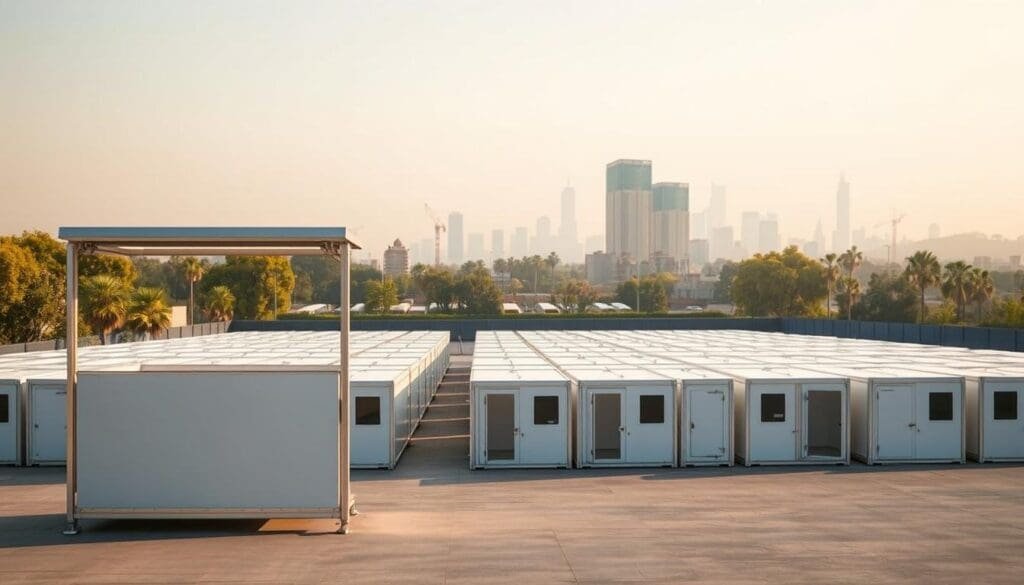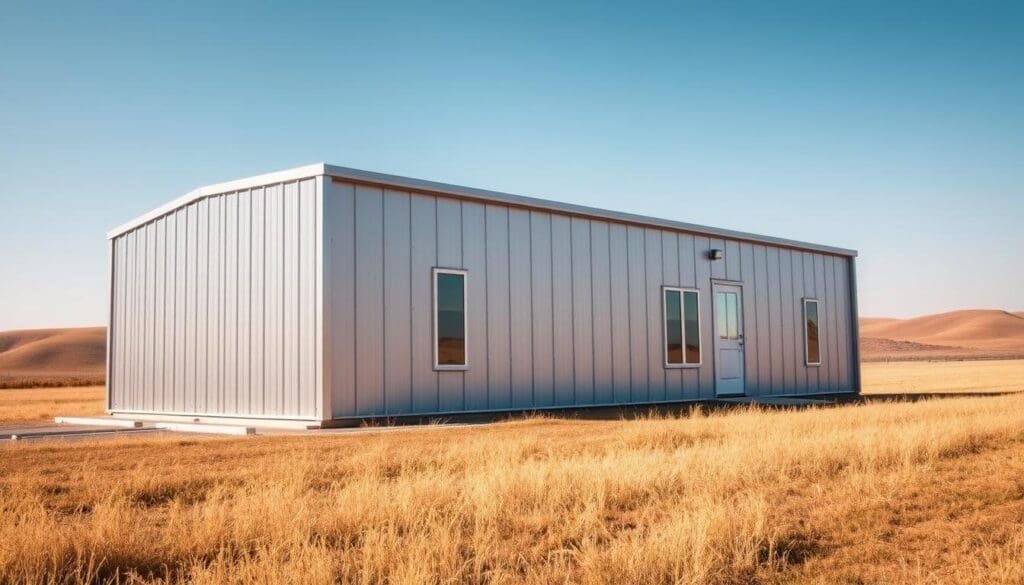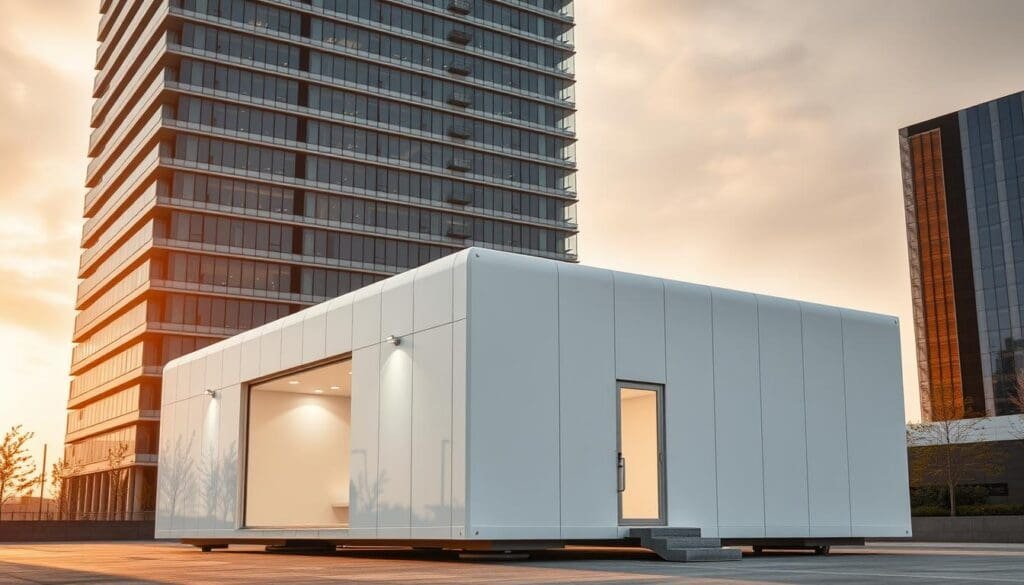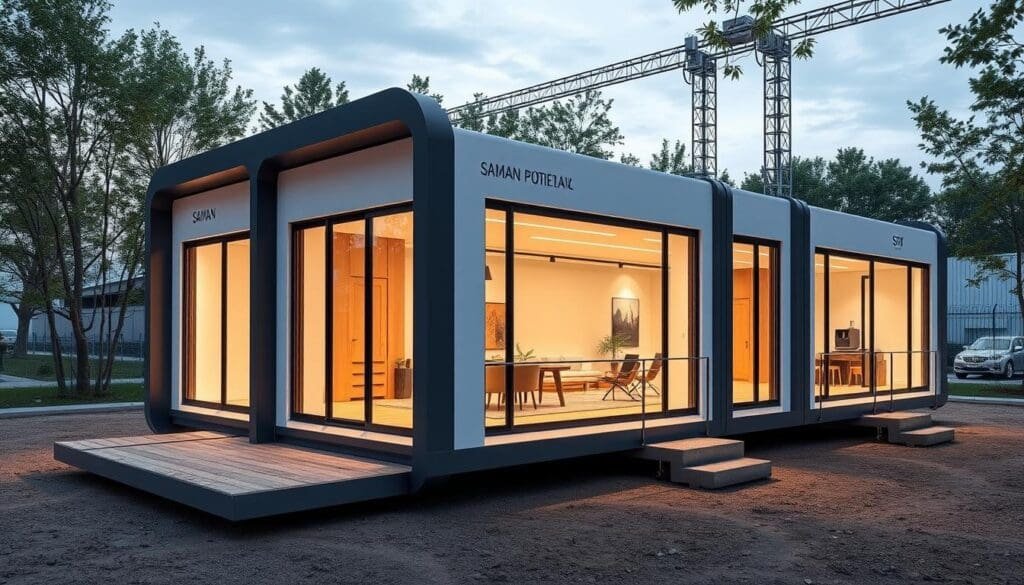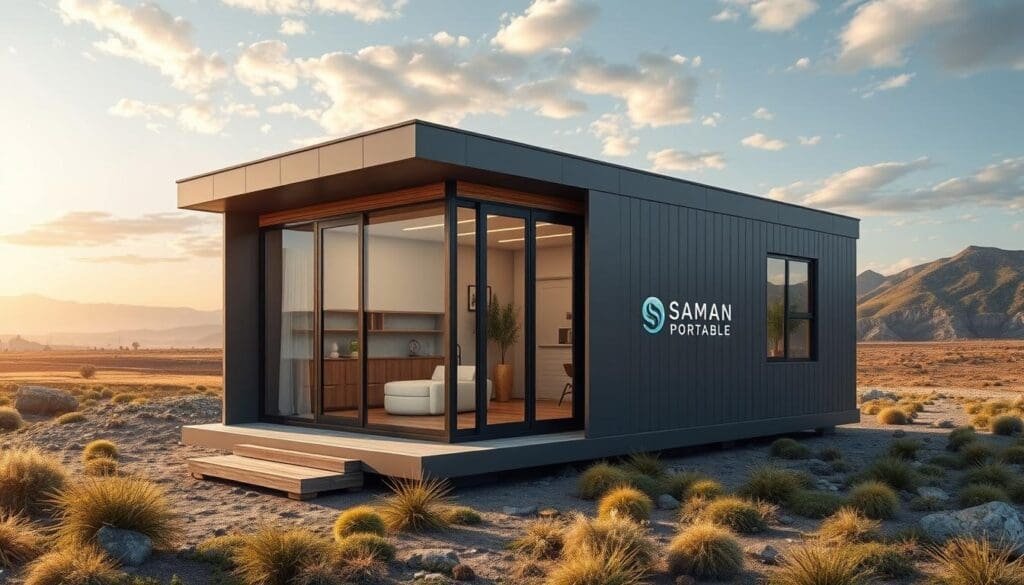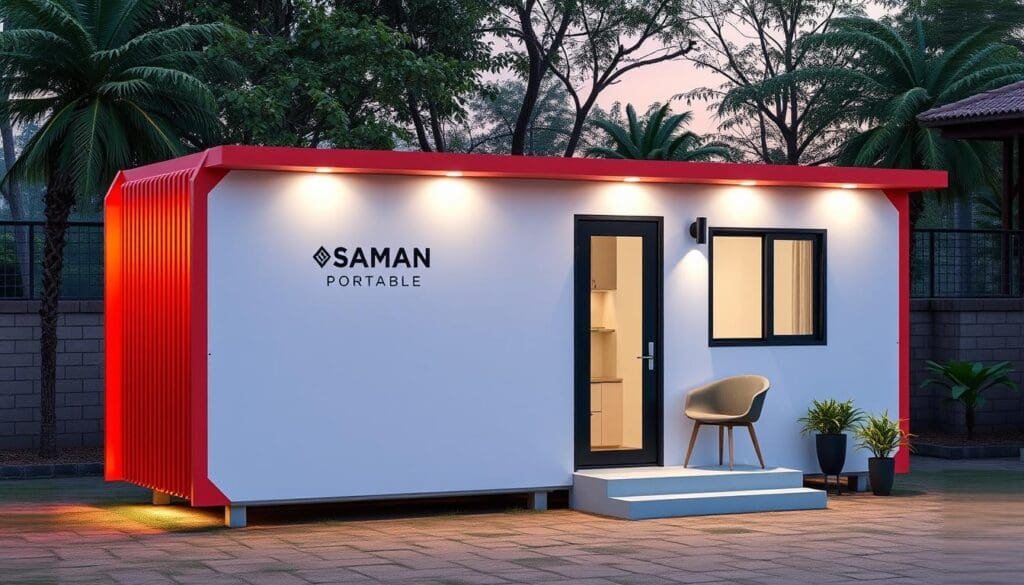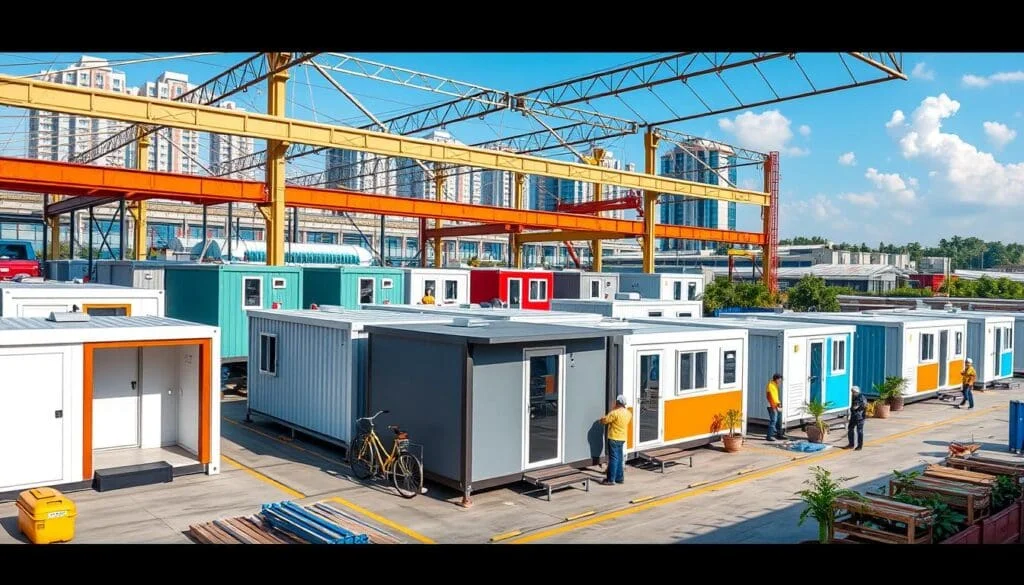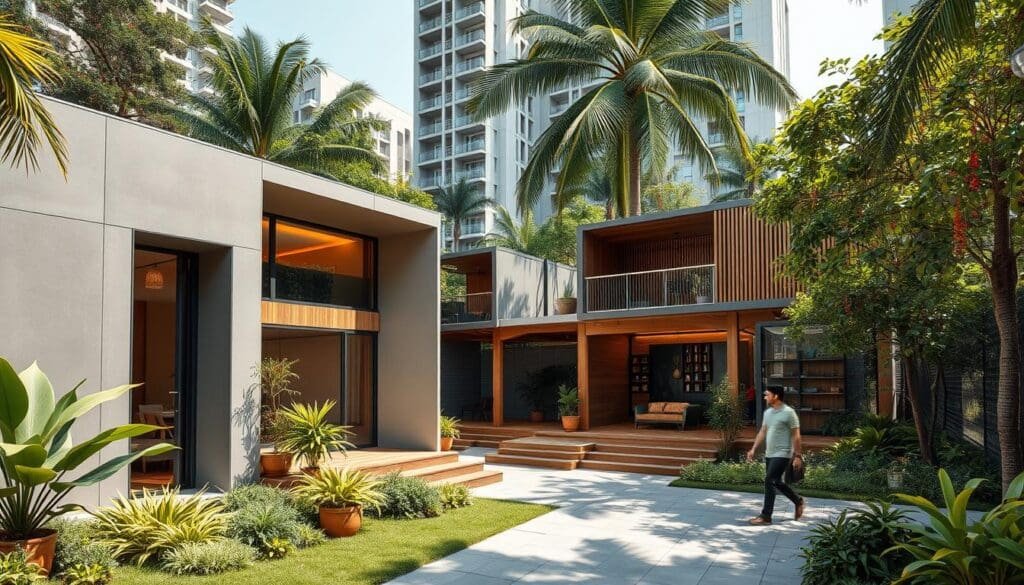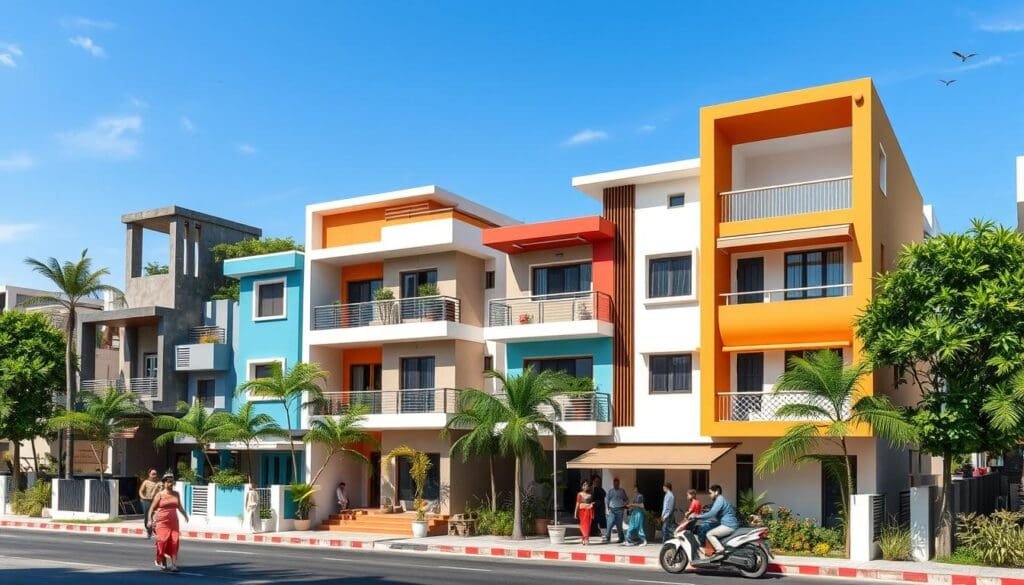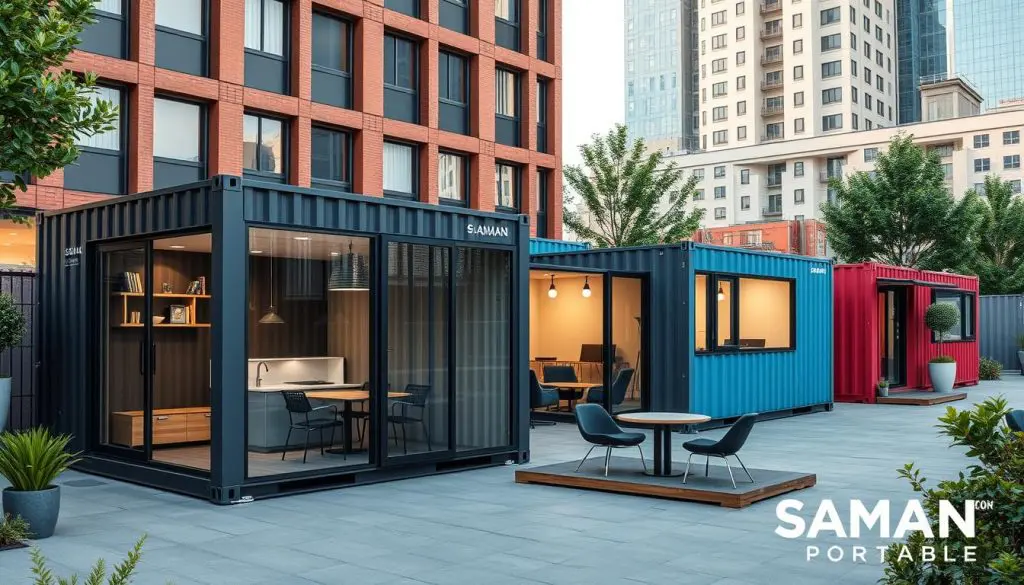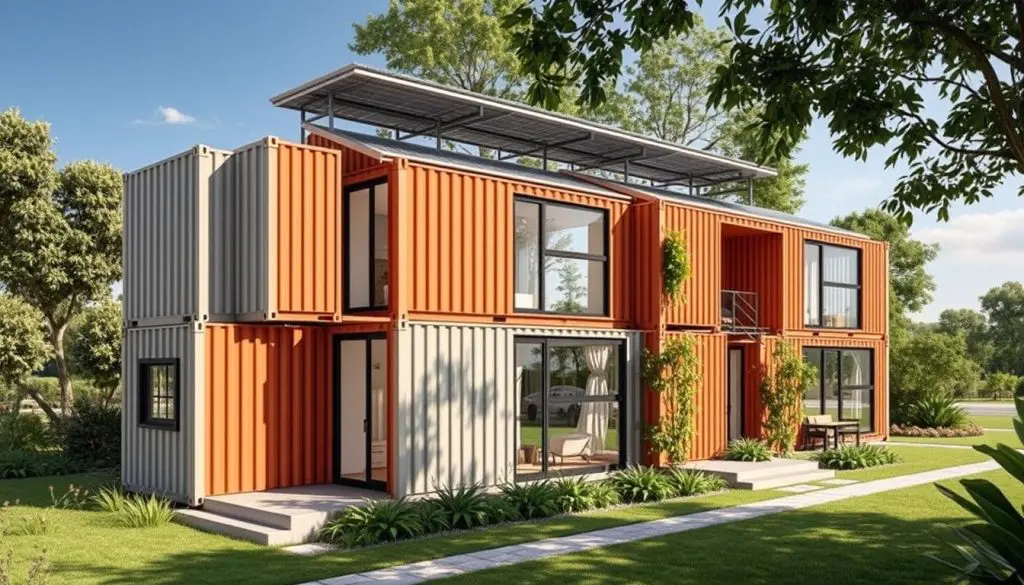Modular Construction: Revolutionizing Porta Cabins and Container Offices
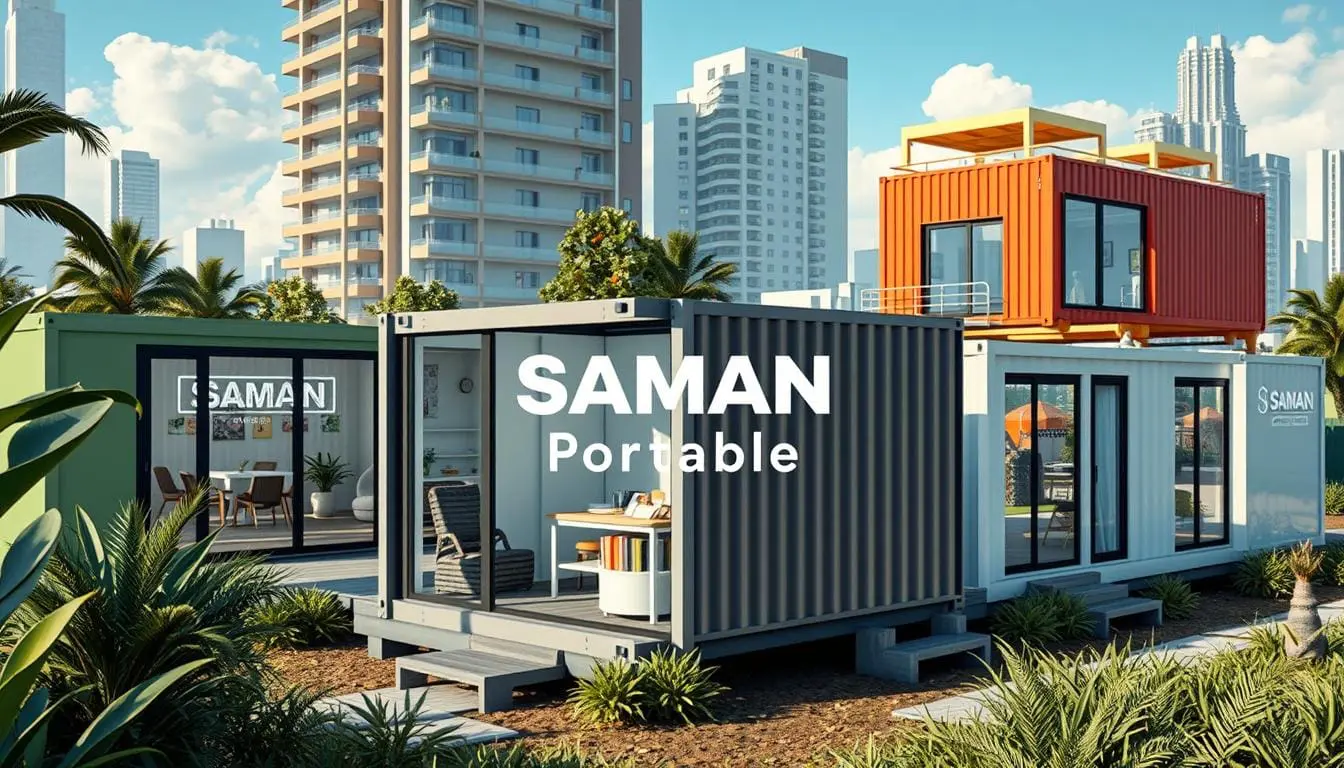
In today’s fast-changing business world, we need flexible, affordable, and green workspace options more than ever. Modular construction is changing the portable building scene. It’s making portable offices and site accommodations better than ever.
Imagine having a ready-to-use, customizable office arrive at your door in just days. That’s what modular construction now offers. It’s bringing new, innovative porta cabins and container offices to the table.
Think about having a portable, prefabricated office that’s easy to move and set up. It fits your exact needs. These modular solutions are changing the game, offering flexibility and saving money. But what makes them special, and how are they changing workspace logistics? Let’s explore the power of modular construction together.
Key Takeaways
- Modular construction is changing the portable building world, offering flexible, affordable, and green workspace solutions.
- Porta cabins and container offices are prefabricated, modular structures that can be set up in days. They save time and money compared to traditional building.
- These innovative solutions work for many industries, from construction to emergency relief. They meet the changing needs of today’s businesses.
- Modular construction lets businesses customize their space to fit their unique needs. It’s all about flexibility.
- Sustainable design and eco-friendly materials are key to modular construction. They help make the future greener.
The Evolution of Portable Building Solutions
The portable building industry has changed a lot. Now, prefabricated portable cabins, portable workspaces, and containerized construction are more advanced. They have changed how we build both temporary and permanent structures.
Historical Development of Modular Structures
Modular construction started a long time ago. In 1837, architect John Manning built the first prefabricated home in London. By 1853, many of these homes were shipped to Australia.
The California Gold Rush from 1848 to 1855 also boosted modular construction. People needed quick and efficient buildings.
Impact on Modern Construction Industry
The construction industry loves modular solutions. They are cheaper, faster, and better for the environment. Companies like SAMAN Portable have made homes like the SAMAN Container House.
These homes are built two times faster than regular ones. They use 65% less material. They are strong and can handle winds up to 240 km/hr. Plus, they make building sites safer.
Current Market Trends
More people want affordable, energy-saving, and customizable buildings. This has made the modular construction market grow. Governments are helping by supporting these methods.
This has led to more modular homes and buildings. New technologies and smart features will make modular construction even better in the future.

Understanding Porta Cabins and Container Offices
Porta cabins and container offices are new, cost-effective ways to build workspaces. They are great for businesses looking for flexible and green options.
Porta cabins are light and easy to move. They’re perfect for temporary offices or remote work. Made from strong materials, they can withstand the weather. They’re set up fast, helping businesses quickly meet their workspace needs.
Container offices, on the other hand, are old shipping containers turned into offices. They can be customized with private areas, meeting rooms, and storage. Their durability and weather resistance make them great for many places.
Both porta cabins and container offices are affordable and functional. They suit many industries, from schools to retail. They offer a green and cost-effective way to build workspaces.

“Portable cabins and container offices eliminate concerns related to delays in construction due to weather conditions, material shortages, or labor issues by enabling quick setup and deployment within a matter of days.”
Key Components of Modular Construction
Modular construction has changed how we build, making it more efficient and green. It uses special parts that make it a good choice for many projects. This includes everything from small cabins to big buildings.
Structural Elements and Materials
Modular buildings start with strong steel frames, tough cladding, and solid floors. These parts are made to move and fit together well. They keep the building strong and last a long time.
Many buildings from after World War Two are still standing today. This shows how well these materials work.
Advanced Insulation Systems
Keeping buildings warm or cool is key in modular construction. This is done with special insulation. For example, polyurethane foam sheets keep the temperature right inside.
This insulation is put in during making, making it work better. It helps save energy and makes buildings more green.
Integration of Smart Technologies
Modular buildings are not just about the structure. They also have smart tech to make life better. This includes things like controlling the temperature and keeping buildings safe.
These smart features make buildings work better for people. They make life easier and more comfortable.
Together, strong parts, good insulation, and smart tech make modular construction special. It’s changing how we build and live in buildings. It’s making construction more efficient, green, and flexible.
| Key Component | Description | Benefits |
|---|---|---|
| Structural Elements and Materials | Steel frames, durable cladding, reinforced flooring | Enhances durability, longevity, and structural integrity |
| Advanced Insulation Systems | Polyurethane foam (PUF) panel sheets | Improves energy efficiency and thermal regulation |
| Integration of Smart Technologies | Automated climate control, security systems, energy management | Enhances functionality, user experience, and sustainability |

“Modular projects have shown an acceleration of project timelines by 20 to 50 percent, and leading real-estate players shifting to modular construction can achieve over 20 percent in construction-cost savings.”
Benefits of Portable Modular Solutions
Portable modular solutions are changing the construction world. They offer flexibility, cost savings, and quick setup. This makes them perfect for site offices, containerized housing, and using renewable materials.
These solutions are very customizable. They can grow or change as your business needs do. This lets companies quickly adapt to new projects or growing demands.
They are also very cost-effective. Building them is faster and cheaper than traditional methods. This saves money upfront and in the long run, thanks to their easy move.
Also, they are good for the environment. They use green materials and are designed to save energy. This meets the growing need for eco-friendly buildings.
Portable modular solutions are great for many needs. They’re perfect for temporary offices, homes in containers, or using green materials. By using these solutions, businesses can make big strides in efficiency and sustainability.

“Modular construction has the power to revolutionize the way we build and live, offering unparalleled flexibility, cost-effectiveness, and environmental responsibility.”
Cost-Effectiveness and ROI Analysis
In the construction world, using sustainable practices and adaptable offices is key. Modular construction, like portable cabins and container offices, is a cost-effective choice. It offers a good return on investment (ROI) because it’s cheaper upfront. This is due to less time spent building, lower labor costs, and less waste.
Modular construction also saves money in the long run. It’s more energy-efficient, has lower upkeep costs, and can be moved or changed as needed. A detailed cost-benefit analysis shows it can be very profitable. This is especially true for businesses that need to change their space or have locations all over.
Initial Investment Comparison
The global construction market is expected to hit $12.9 trillion by 2024. This highlights the need for affordable solutions. Modular construction, like pre-engineered buildings (PEB), can save 10-20% compared to traditional methods. This is because it’s faster, uses less material, and is more efficient with labor.
Long-term Financial Benefits
Modular construction also has long-term financial perks. It’s designed to be energy-efficient, which means lower bills. It also uses durable materials that need little upkeep. A study showed a PEB project cut construction time by 30% compared to traditional methods, boosting ROI.
Maintenance Cost Considerations
Maintenance costs are important when looking at ROI. Portable cabins and container offices are built to last. They use high-quality materials and finishes that need less upkeep. This means lower maintenance costs over time, which helps with ROI.
When looking at initial costs, long-term savings, and maintenance, businesses can make smart choices. Modular construction is a cost-effective and efficient way to achieve sustainable and adaptable offices.

Sustainable Design Features
The world is moving towards a greener future, and the modular construction industry is leading the way. Portable cabins and container offices are at the forefront, thanks to their eco-friendly and energy-efficient designs.
Modular construction uses recycled or repurposed materials, reducing environmental impact. It promotes a circular economy in the construction world. Advanced insulation, like PUF panel sheets, keeps temperatures comfortable and cuts down on heating and cooling needs.
- Modular construction cuts down on construction time by building parts offsite and preparing the site at the same time.
- It produces less waste than traditional methods and modules can be reused, saving raw materials.
- Using sustainable materials like recycled steel and bamboo reduces carbon emissions compared to traditional materials.
Modular construction goes beyond just using sustainable materials. Many portable cabins and container offices come with solar panels, LED lights, and smart energy systems. These features boost their energy efficiency and green construction status. Their ability to be moved and reused also helps reduce waste, showing they are true eco-friendly buildings.
“Proponents of modular construction argue that it can deliver greater environmental and social sustainability benefits compared to traditional construction methods, including reduced material waste, reduced disruption to building sites and communities, safer working conditions, and reduced operational energy.”
The modular construction approach is a game-changer in sustainable design. It’s leading the construction industry towards a more environmentally friendly future.

Customization Options and Flexibility
Portable cabins and container offices have a lot of modular design and modular architecture options. They can be customized to fit different business needs. This makes it easy for companies to create spaces that are just right for them.
Layout Configurations
Businesses can change the layout to meet their needs. They can choose from open-plan offices, private areas, or a mix. This flexibility helps the workspace grow with the company.
Interior Design Solutions
Interior designs for these structures are also very flexible. Companies can pick from many finishes, lights, and furniture setups. This lets them make a workspace that reflects their brand and style, boosting employee happiness and productivity.
Scalability Options
The ability to grow or shrink is a big plus for businesses. As needs change, adding or removing units is easy. This keeps the workspace efficient and well-used.
Portable cabins and container offices are great for businesses wanting a custom, flexible, and green workspace.

| Customization Aspect | Benefits |
|---|---|
| Layout Configurations |
|
| Interior Design |
|
| Scalability |
|
“The flexibility and customization options offered by modular construction are game-changers for businesses seeking adaptable workspace solutions.”
Transportation and Logistics Management
The success of prefab construction, modular components, and offsite construction depends on good transportation and logistics. Moving these large structures needs special equipment and careful planning. Logistics teams must deal with oversized load rules, get the right permits, and ensure safe transport to the site.
It’s important for manufacturers, transporters, and on-site teams to work together smoothly. Being able to move these modules to hard-to-reach places makes them a great choice for many projects. But, the industry still needs to improve its supply chain to handle any unexpected issues.
Leveraging Technology for Optimized Logistics
New tech like 4-D Building Information Modeling (BIM) gives real-time updates on vehicle and material status. By combining BIM with a common data environment (CDE), teams can manage project info better and plan logistics more efficiently. This helps solve the problem of integrating supply chain logistics with 4-D BIM, a big challenge in the UK construction world.
| Technology | Benefits |
|---|---|
| Building Information Modeling (BIM) |
|
| Common Data Environment (CDE) |
|
Using these tech advancements, the modular construction field can improve its transport and logistics. This ensures prefab components are delivered on time and installed without delays.

“Efficiency in transportation and delivery is crucial for modular building projects to remain on schedule and within budget. By focusing on smart logistics management, we can cut costs while prioritizing speed and safety.”
Adopting lean principles and multi-objective optimization systems in logistics planning can help the industry. As prefab construction demand grows, the industry’s focus on improving transport and logistics will be key to its success.
Installation and Setup Process
The setup for rapid construction, customizable layouts, and prefabrication of portable cabins and container offices is quick and efficient. It involves six main steps: designing the structure, engineering review, getting permits, site preparation, module delivery, and final installation.
Site Preparation Requirements
First, the ground is leveled and drainage is ensured. Utility connections are also set up. This step is key for the structure’s stability and function. Before starting, you need to get various permits, like building and plumbing permits.
Assembly Techniques
Assembling the modules involves connecting them and securing them to the ground. Contractors with expertise in modular construction oversee this to ensure everything is right. The design allows for customization, making it flexible and tailored to your needs.
Quality Control Measures
Quality checks are done throughout the rapid construction process. This ensures the final product meets safety and performance standards. Modular construction is safe for workers and follows local building codes.
This efficient setup means businesses can have their workspaces up and running faster than with traditional methods. It’s becoming a top choice for modern projects.

| Step | Description |
|---|---|
| Designing the Structure | The modular building is designed with consideration for functionality, aesthetics, and compliance with regulatory requirements. |
| Engineering Review | The design is reviewed by engineers to ensure structural integrity, safety, and performance. |
| Permits and Approvals | Necessary permits, such as building, plumbing, and mechanical permits, are obtained before construction begins. |
| Site Development | The site is prepared, including excavation for the foundation, water management systems, utilities, and walkways. |
| Delivery | The prefabricated modules are transported from the factory to the installation site using specialized cargo carriers. |
| Installation | The modules are carefully aligned and secured to the foundation, with the process supervised by a modular construction specialist. |
Applications Across Different Industries
Modular workspace solutions, like porta cabins and container offices, are versatile. They fit well in many industries. These include construction, education, healthcare, and remote work sectors.
In construction, they act as offices, meeting rooms, and storage. This keeps business running smoothly while buildings are being made. Schools use them for extra classrooms or offices, offering quick and easy solutions.
Healthcare benefits from them too. They can be used as mobile clinics or to add more hospital space when needed. For industries like mining and oil, these buildings are strong and can move easily. They help support work in tough places.
Government agencies also find them useful. They use them for disaster relief and temporary offices. This helps them respond fast to new needs.
Modular construction is great because it can be changed and customized. It’s perfect for modular workspace, construction technology, and temporary structures. It changes how businesses and groups think about their workspaces.
| Industry | Application of Modular Workspaces |
|---|---|
| Construction | On-site offices, meeting rooms, storage facilities |
| Education | Temporary classrooms, administrative spaces |
| Healthcare | Mobile clinics, additional hospital capacity |
| Remote Industries | Mining, oil exploration, and other remote operations |
| Government | Disaster relief operations, temporary administrative centers |
Modular workspaces are flexible and meet many needs. They’re becoming more popular for businesses looking for flexible, affordable, and green workspaces.
“Modular construction is the future of the built environment, offering unparalleled speed, flexibility, and sustainability across industries.”
Regulatory Compliance and Safety Standards
Modular construction follows strict rules to ensure safety. It meets or goes beyond what’s required. Building codes for these structures vary by area but focus on strength, fire safety, and access. Suppliers and makers get safety certifications to prove their products are safe.
Building Codes
Building codes for modular buildings aim to keep them strong, safe from fire, and accessible. These rules help keep people safe and the buildings sound. Following these codes is key to making sure the buildings are safe.
Safety Certifications
Safety certifications are crucial in the modular building world. They show these buildings meet health and safety standards. Suppliers and makers work hard to get these certifications, showing they care about safety.
Environmental Regulations
Environmental rules in modular construction focus on saving energy, cutting waste, and using green materials. Makers aim to create buildings that are good for the planet. This makes the modular construction sector a leader in green building.
Using new tech like AIM and BIM has changed how companies follow rules. These tools help manage compliance better, making the process faster and safer. As the field grows, staying safe and green is key to success.
“Companies that follow rules well are seen as good in the industry. Not following them can lead to big safety problems, legal issues, and money losses.”
Innovations in Modular Technology
The modular construction world is changing fast. It’s moving towards [construction efficiency], [smart buildings], and using [renewable materials]. New materials like graphene-enhanced steel and 3D printing are changing how we build portable cabins and container offices.
Smart building systems are a big deal now. They use the Internet of Things (IoT) to save energy and make buildings more comfortable. They also give real-time data to help businesses work better and greener. Using materials like engineered timber and recycled plastics is also making the industry more eco-friendly.
3D printing is changing how we make modular parts. It lets us create custom parts on-site, cutting down on waste and making assembly easier. Augmented reality (AR) tools help in design and construction, letting people see projects in real scale and improve accuracy.
These new technologies are making modular construction better and more flexible. As the industry grows, we can expect even more advanced, adaptable, and green solutions for businesses.
“The combination of BIM with modular construction significantly improves design and fabrication workflow efficiency.”
Embracing the Future of Modular Construction
The modular construction industry is getting ready for a big change. With new tech, we’ll see better energy use, custom designs, and more. [Innovations in modular technology] are leading us to a more sustainable, efficient, and flexible future.
SAMAN Portable Office Solutions is at the forefront of this change. They offer custom solutions for offices, homes, industrial spaces, and more. They make sure each structure fits the specific needs of their clients.
Future Trends and Market Outlook
The future of modular construction is looking bright. Sustainable design is becoming more important. This means we’re seeing more zero-carbon modular buildings. They help the environment and save money in the long run.
Advanced technologies like AI and machine learning are also changing the game. These tools make designing and building modular homes more precise and efficient. They offer more options for customization, making construction faster and more flexible.
Modular construction is key in solving urban housing shortages. It’s fast, affordable, and can be scaled up. This makes it perfect for governments and developers looking to build more homes and public facilities quickly.
The market for portable and modular buildings is growing fast. It’s expected to hit $172.4 billion by 2025. This growth is driven by the need for flexible, affordable, and green building solutions in many sectors.
| Segment | Market Share (2023) | Projected CAGR (2020-2025) |
|---|---|---|
| Relocatable Modular Construction | Largest Revenue Share | – |
| Permanent Modular Construction | – | Significant Growth |
| Steel Material | Dominant | – |
| Concrete Material | – | Substantial Growth |
| Asia-Pacific Region | Largest Market | – |
| Residential Sector | Highest Market Share | 8.04% |
These trends show that modular architecture and prefabricated buildings are becoming more important. As we look for better, cheaper, and greener ways to build, modular construction is set to change the game. It’s going to revolutionize how we design, build, and use our buildings.
“Modular construction is not just a trend, but a fundamental shift in the way we build. It’s a solution that addresses the challenges of our time, from sustainability to affordability, and I believe it will continue to shape the future of the construction industry.”
Conclusion
Modular construction, like porta cabins and container offices, is changing the game in the building world. It brings flexibility, saves money, and is good for the planet. This makes it a top pick for companies looking for flexible and modern workspaces.
As tech gets better and we care more about the environment, modular building will keep growing. Companies using these methods will see faster builds, better energy use, and less waste. They’ll also get to keep high quality and customize their spaces.
By going modular, companies can meet changing needs and green goals. They’ll stand out as leaders in their fields. The future of porta cabins and container offices is bright. It promises to change how we design and build workspaces.
FAQ
What are the key benefits of modular construction for porta cabins and container offices?
Modular construction is flexible and cost-effective. It allows for quick setup and is good for the environment. These structures can be changed and moved as needed. They save money and use green materials and energy-saving features.
How do porta cabins and container offices differ in terms of design and functionality?
Porta cabins are smaller and lighter, great for temporary offices. They are easy to move. Container offices, made from shipping containers, are strong and can be customized. Both are affordable and functional.
What are the key components and materials used in modular construction?
Modular buildings use top-notch materials like steel and durable cladding. They have advanced insulation for better energy use. Smart tech, like climate control and security, is also included.
How do modular solutions compare to traditional construction in terms of cost and return on investment?
Modular construction is cheaper than traditional building. It saves money upfront and in the long run. It’s energy-efficient and has lower maintenance costs. This makes it a smart choice for businesses that need to change or expand.
What are the typical applications and use cases for porta cabins and container offices?
These structures are used in many fields like construction and healthcare. They work as offices, meeting rooms, and classrooms. They offer flexible and quick solutions for various needs.
How do modular construction solutions address sustainability and environmental concerns?
Modular buildings are designed to be green. They use recycled materials and are energy-efficient. This reduces their environmental impact. They also use smart energy systems to save more.
What are the key considerations for the transportation and logistics of modular buildings?
Moving porta cabins and container offices needs careful planning. Special equipment is used to handle their size and weight. It’s important to follow rules and get the right permits for a smooth delivery.
What are the key innovations and technological advancements shaping the modular construction industry?
The industry is growing fast with new tech. Materials like graphene-enhanced steel and 3D printing are being used. Smart systems and augmented reality are making these buildings more advanced and flexible.
 Container Cafe
Container Cafe
















































































